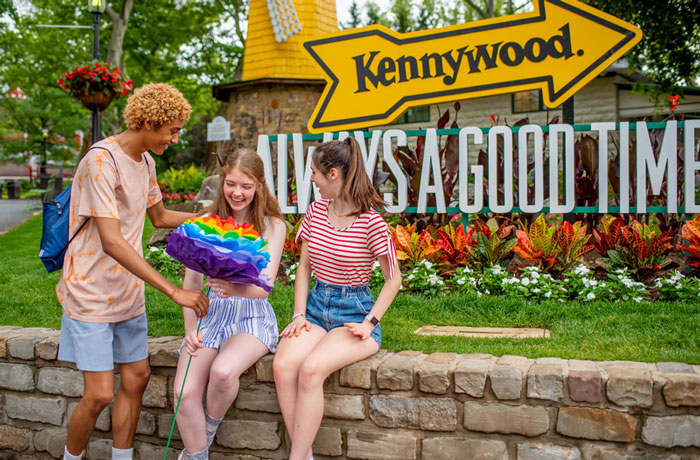“If you build it, they will come.” Most of us have heard that old movie line, but it’s a safe bet that those who own and operate waterparks are not considering this a sound business strategy. With so much investment and planning going into these facilities, venues need to have solid marketing plans in place, and be prepared to experiment and pivot as they discover what works best to promote their attractions and features, programs and non-water amenities to attract visitors in the competitive recreation industry.
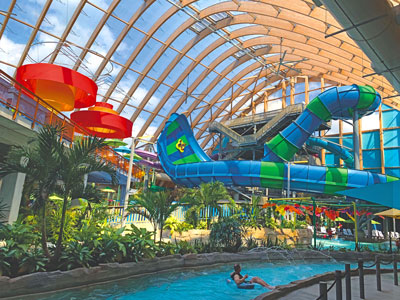
Marketing strategies don’t just take shape when a facility is about to open, but often in the planning stages. Josh Martin, president and creative director at Martin Aquatic Design & Engineering, said they study market analysis to ensure that clients are looking at their competition and “what bragging rights you might be able to roll the development out of,” as it’s “more exciting to have a theme or a story that you can launch.”
He said that early on in the design process they’re seeing operators selected, and they’re designing spaces that are flexible for seasonal opportunities. “An outdoor waterpark might have a floating Christmas exhibit on their lazy river, or there might be a great location for a stage over the top of a pool that’s closed in the winter, so we engineer the supports for the structure to allow this to happen.”
He said the strategy of offering programming both when “guests are wet” and when the park isn’t operational is “more and more a focus on ground-up design.”
Waterparks are often regional destinations, and operators need to decide how far they’d like to extend their marketing reach. Chris Nawracaj is general manager at Deep River Waterpark in Crown Point, Ind., about 50 miles from Chicago. He said that most of their radio ads are on Chicago stations, which run throughout the year and have proven extremely successful. “We also do a lot of billboards in the Chicago area… it’s a huge market for us. We also market across all of northern Indiana and into southern Michigan as well.”
Deep River is operated by Lake County (Ind.) Parks & Rec, and Nawracaj said they’ve always worked with an outside marketing firm for the waterpark, who he said really understands their business and needs, making for a great partnership. “They also manage all of our social media. We don’t even have to think about it because they’re always on top of it.”
Of course, everyone likes to save money, and promoting your discounts and specials can get people’s attention. Nawracaj said their special deals are hugely popular, especially an online-only package consisting of tickets, an ice cream and unlimited soft drinks for the day, which “encourages people to buy their tickets online ahead of time. On a busy weekend we’ll generally sell upward of 100 of those a day.”
Special days discounting groups like seniors and military personnel are also popular, according to Nawracaj, and partnering with community organizations like a food bank or the Humane Society for promotions can also be win-win situations. “People love coming out to support them and often bring way more food than required for the discount.”
In Riviera Beach, Fla., Rapids Waterpark also offers online-only specials, as well as hotel packages. “We’re very active with our local chambers of commerce, Visit Florida and Discover the Palm Beaches,” said Audrey Padgett, director of marketing and sales. “Bed taxes are vital for our tourism, so we’re always glad to work with hotels in creating ticket/room packages. It’s very common now for waterparks and amusement parks to run flash sales during the season; everyone does them because they’re successful.”
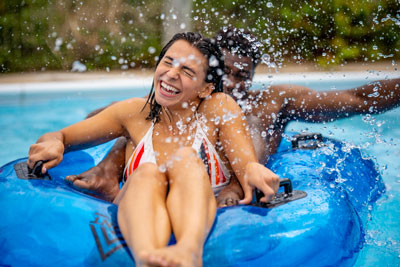
Tina Hatcher is founder of 3i Advertising/PR, and they count several waterparks as clients, including Rapids. She stressed how important it is for parks to promote new products, attractions and special events through a variety of efforts including press releases, though she explained that media outlets have changed since COVID, with less outlets available and more working remotely. “Influencers and blogs have continued to grow, and including them in your news releases is important. Plus, some sites will allow you to submit a release or add your events to their website’s event calendar.”
She said websites are still vital marketing tools, listing a park’s attractions, safety restrictions, pricing, hours, special events, FAQs, rules and procedures, group offerings, and cabana and park information. She pointed out that while many people want immediate information through social media platforms or apps allowing for real-time connection, it’s important to send people to your website for official information.
“We’ll use social media posts and emails to promote special events, promotions and offers with a link to the website for more information or to purchase,” said Hatcher. She explained that you want to have tracking pixels on your website in order to retarget people who’ve visited your site with paid social media or digital ads. “If you’re not getting website visits through SEO (search engine optimization) or organic search, you can do social media contests or run Facebook paid campaigns for page views or website visits.”
Email marketing is very effective, and Hatcher mentioned seeing “a direct correlation with increased sales from emails.”
She suggested segmenting your database versus sending every email to everyone, such as separating lists for season pass holders or ticket and cabana purchases by year; group and birthday bookings; contest signups and general signups. She pointed out newer compliance updates for email communication including opt-in and list verification. “You also need to make sure your point-of-sale system will allow you to pull this email data for future use.”
Additionally, “We do have parks that run a monthly contest for people who sign up for a chance to win tickets.”
In Ohio, Zoombezi Bay is part of the Columbus Zoo, with all proceeds from the waterpark supporting the zoo and aquarium. Anthony Sabo is vice president of the waterpark and guest services, and he said they actively use email to keep season pass holders and previous visitors informed about upcoming events and special offers. “We also partner with trusted third-party providers (of email lists) to expand our reach and connect with new audiences.” Print media is also utilized, and “press releases continue to be useful in sharing information with media outlets, who often post these releases on their websites.”
Sabo said that local radio stations and TV frequently visit “for live hits at the waterpark, showcasing attractions and sharing upcoming events. We also strategically place radio and TV advertising to effectively reach both local and regional audiences. By targeting key markets within our region, we ensure that our messaging resonates with families, the 21-plus crowd, adventure-seekers and more. Radio spots provide frequent reminders and build anticipation, while TV commercials showcase the vibrant, action-packed experience that awaits our guests.”
Nawracaj said that local newspapers visit their park, take pictures and do stories on the season opening, etc. “We’ve filmed segments for TV as well. We’ve been on the Travel Channel when we opened our… mat racer slide, and we occasionally do things with the local PBS station.”
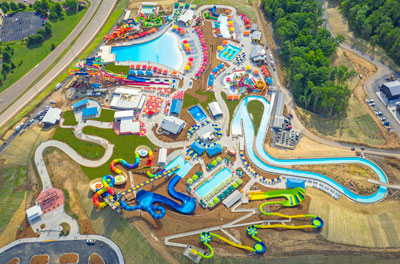
Pittsburgh-based Palace Entertainment owns and operates a variety of destinations including several waterparks, which work closely with TV and radio stations, according to Lynsey Winters, director of communications. These stations are included when releasing news or sharing park info in general. “Several parks in our portfolio also run paid advertising across several local radio stations in their markets.” Print media is also targeted through PR campaigns.
Whenever a park launches a new attraction or event series, Winters said they “take a 360-degree marketing approach. We announce the news on social, through our CRM (customer relationship management) channels, website and with a press release targeted to local and industry media.”
An email database is used for informing season pass holders and past single-day ticket holders on upcoming events, current ticket or pass deals, changes to park policies and to announce new events, entertainment, rides and more, according to Winters. She said it’s extremely important to ensure their parks’ websites are up to date as this is where guests get their information when planning a visit. “We also use our websites to offer our guests the best deals on season passes and tickets.”
Nawracaj said they also reach out by mail to “companies trying to get them to book groups.”
Hatcher said some of their parks also utilize direct mail, typically for group sales and targeting businesses. “There are direct-mail opportunities in several markets that are willing to do cash/trade or a complete trade for tickets. For targeting locals and tourists, we’re using a media mix based on media research, surveys, data and cost for impressions. Paid social media and digital spends continue to increase within all park budgets because you can monitor the spend, reach, geo-target by location, interest, demographic and adjust campaigns quickly for impressions and return on ad spend (ROAS).”
Hatcher said that social media is still king, though she cautioned against focusing “on all reels or stories. Though this will increase video views—which is a vanity metric—we’ve seen a drop in engagement if it’s all video content. You should have a good mix of both static and video. Instagram, Facebook and TikTok are still in the lead.”
She pointed out that user-generated content (UGC) is also great for sharing on social platforms. “We like running photo contests for this purpose,” noting in contest rules that photos submitted can be used on the park’s social media. And she added that influencer visits are also an important part of social media.
Nawracaj said they strive to be interactive and “re-post people who’ve visited the park and tag us in their content. It helps build that consumer relationship and promotes the brand all around.”
Sabo said their social media serves a variety of purposes, including communicating park hours and updates, sharing summer event information, promoting discounts and in-park opportunities, and “telling the larger story of how Zoombezi Bay supports wildlife conservation next door at the Columbus Zoo and Aquarium.”
He said their social media team shares stories in traditional social media posts year-round but “also connects with new audiences with video content like Instagram Reels and TikTok videos.”
“We have a big social media presence, and a lot of people want to be a part of it, so we have to be very selective,” said Padgett, who added that Rapids has a very active fan base. “We use both organic and paid social to build awareness of upcoming events and offers. We use it organically to inform people what the park is about, our attractions and offerings, and how to plan your visit.”
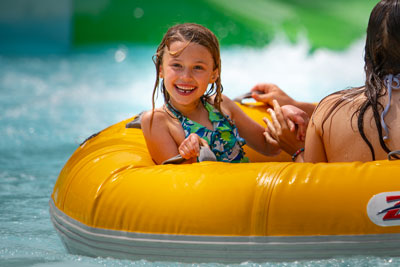
Padgett said they do regular email blasts in their marketing and communications efforts, but “Like a lot of advertisers, we moved from traditional broadcast buys to a more digital-focused media plan including search, social, OTT (over-the-top) and OLV (online video). We feel this is where we can best reach our demographic audience, but we also utilize OOH (out of home) and radio since we’re in a big drive market.”
Collecting data and feedback from visitors through surveys is crucial for targeting marketing campaigns effectively, according to Hatcher, as this helps with understanding the preferences, behaviors and demographics of visitors, along with “improving ROI, enhancing the customer experience, identifying market opportunities, optimizing market channels, and building trust and credibility.”
She said this information helps create targeted marketing strategies that resonate with the “specific needs and desires of the audience, leading to more personalized and effective campaigns.”
Nawracaj said their parks department recently started using location intelligence and foot traffic data software. “It’s interesting to see such detailed data about your customers. We hope to be able to learn more about the customers coming to our parks and facilities and how we can reach them better.”
Of course, marketing efforts are most effective when there are things to promote, and holding special events is a great way to bring renewed interest to a facility, especially if a park has “not added a new attraction for several years, as it provides customers with a new experience—and reason—to come visit,” said Hatcher.
She listed some popular events, including adult-only nights, daytime foam parties, dive-in movies, mermaids and character visits, and live music.
All of our contributors are big proponents for staging and promoting special events. Nawracaj mentioned their recent Taylor Swift-themed night where they renamed food stands to fit the theme, had photo opportunities and played Swift’s music. “We had just under 2,000 people purchase tickets and show up for that event.” The park hosts ice skating in the winter, and he said they generally have “some sort of theme night each weekend.”
Sabo said they looked to extend operations with late nights and installed a full park lighting system. “We now host our popular Summer Nights every Friday in July which features late night operation of our most popular attractions and a dive-in movie in our wave pool.”
He said tickets to their Waterpark After Dark events—specifically for guests 21 and up—include two drink tickets and limited capacity for a more intimate experience. “We’ve sold out every single event since 2020.”
This year, he said, they’re holding an Oktoberfest event in early September, as “we see a lot of demand from our guests asking us to extend our operating season.”
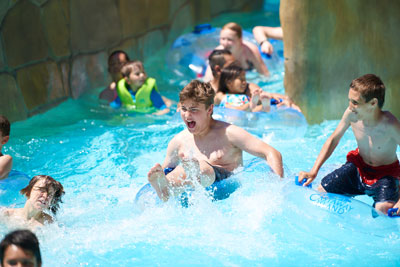
Epic Waters is the largest indoor waterpark in North Texas, and in October they hold FlowaPalooza, a two-day festival taking place in the waterpark and on their lawn. According to Michelle Hernandez, marketing and social media director at the park, the fest serves two purposes: global exposure for their surf attraction riders and providing “an Epic experience for the community with a family-friendly event, featuring live entertainment, local food booths and trucks, a rock climbing wall, laser tag, caricature artists, face painting, local vendors, lawn games and more.”
Additionally, Hernandez said they offer “cruise ship entertainment on land,” celebrating holidays including New Years, spring break, Cinco de Mayo, Memorial Day, Labor Day, Halloween and more. “We have a very popular Breakfast with Santa during the holidays.”
Padgett said they’ve added Adults Only/DJ Nights, which have been “very popular, targeting new audiences that might not regularly come to the park.” Daytime foam parties have been popular, as “both parents and kids love playing in that foam.” They offer dive-in movie nights and have hosted celebrities and Miami Dolphins players at different events, some of which are promotions aiding a local food bank.
Bringing it back to the planning stage, Tim Sheehan, manager of planning at Aquatic Development Group, said programming is one of the first considerations before working on a park layout. “Who are the users? Are there nighttime activities? How is it staffed? How is food prepared and delivered? What happens with trash?” He suggested including a large video screen for swim-up movies, and mentioned a client who included a large stage and catering area to host luaus and cookouts for corporate events and large family gatherings with “more of an upscale feel and the ability to operate within a limited section of the park.”
“It may be difficult to directly market that a project is well-designed, but good client experiences and stellar reviews can definitely sell a park,” continued Sheehan. “Good visitor experiences come from thoughtful, smooth and safe operations, appropriate wait times, good food, cleanliness, well-trained staff, etc. If a guest has a good time, they will definitely tell others, and vice versa.” RM



